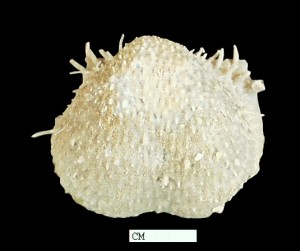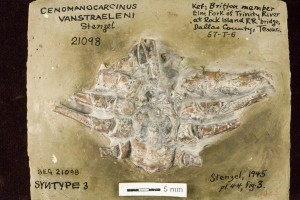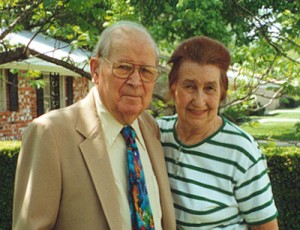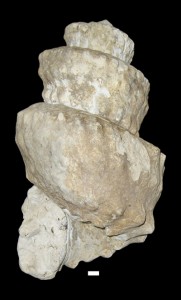Invertebrates
Arthropods
Collections at this repository contain a wide variety of arthropods with interesting type specimens of crabs and lobsters from the work of Mary J. Rathbun and Henryk Stenzel. The large collection of trilobites catalogued into the Bureau of Economic Geology collection was transferred (PDF) to the Smithsonian in 1973.
Brachiopods
The majority of the brachiopod collection resides within the stratigraphic collection amassed by the Bureau of Economic Geology during their geological mapping of Texas. Additional specimens are continually being added to the collection from numerous other research projects. The brachiopod collection is an important resource for those interested in interspecies variation and in relationships between brachiopods and other organisms.
The Emmette Wallace Collection
A global taxonomic collection of brachiopods of Emmette Wallace, numbering about 4,000 specimens, was donated by his widow, Jean Wallace in 2002. Wallace collected specimens from all over the world endeavouring to cover as much of the taxonomic breadth as possible. The collection has about 600 genera represented. He meticulously curated them and each specimen was catalogued into a card index and thence to a digital database providing an accessible and interesting resource. Wallace accepted in large part the identifications that came with the purchased specimens. A reexamination by Judy Lundelius, using the recently published Brachiopod Treatise, has corrected some misidentifications. A few specimens, some lacking sufficient data, need further work.
Search the Wallace Brachiopod Database.
The Glass Mountains

Rhamnaria kingorum (IBR0484) from the Word Formation, Permian, collected in the Glass Mountains of West Texas.
There are some wonderful fossils in the Glass Mountains of West Texas preserved as ‘glass’, or more accurately their original shell has been replaced with silica. During the Permian this area of Texas was a shallow warm ocean and the rocks representing that time period include many marine organisms. In addition to brachiopods there were sponges, bryozoa, crinoids, corals, and many others. Those fossils that were replaced by silica can be extracted from the limestone by dissolving the limestone. The resulting silicifed specimen retains incredible detail and much fragile structure that would normally be lost. Learn more about the Glass Mountains.
Reef and Mound Builders
Corals
Coral collections at NPL include recent comparative scleractinian corals assembled by Lang and others, Cretaceous corals collected by Francis Whitney, Wells and others, Paleogene corals collected by Frost, Schafersman, and Garvie, and Paleozoic tabulate corals assembled by Christopher Durden. In addition to those are the specimens that were collected as part of the geologic mapping of Texas. The coral collection includes specimens from all major groups. There are types from the work of Wells and Whitney and a large collection of Damon Mound corals from the work of Scott and Schafersman and later researchers.
Rudist Bivalves
Rudist bivalves are limited to the Late Jurassic and Cretaceous. Our collection of about 14,000 specimens comes from Texas, Mexico, the Caribbean and to a lesser extent Europe. A wide range of researchers are responsible for this collection but the majority of specimens were collected by Myers and Keith Young. European and Jamaican specimens have been added by Ann Molineux. This collection was in part responsible for the selection of Austin as the site for the Seventh International Congress on Rudists in 2005.
Chaetetid Sponges
Chaetetid sponges are currently placed in the order Tabulospongida. Our collection includes that of R.J. Stanton and many specimens collected during the Bureau of Economic Geology State mapping project.
Echinoderms
Our collections include echinoderms from the Cambrian period to the Recent. Of particular importance are the early Paleozoic specimens collected from the western USA and studied by James Sprinkle and his graduate students. Many of these specimens are new species and are located in the type collection. Another strength lies in Tertiary echinoids from the Gulf region. Many specimens were collected in the earliest explorations of the state and form part of the Rio Bravo Collection. A locally famous slab of fossil starfish from the NPL collections is on display at the Texas Memorial Museum.
Molluscs
Cephalopods
There are substantial collections of cephalopods in the repository. These fossils were, and still are, important index fossils, helping geologists connect surface outcrops with buried rock strata of similar age. Many of the specimens were collected by early geologists at the Bureau of Economic Geology including Walter S. Adkins and later by Keith Young. Recent accessions include those from Keith Minor, one of the most prolific avocational ammonite paleontologists in Texas, and James Conln who worked closely with Kennedy and Cobban in their re-examination of Cretaceous ammonites of Texas.
Bivalves (pelecypods)
Sponges
The collections include hexactinellid (glass) sponges, calcareous sponges and calcified demosponges. Perkins sponge collection: A collection of Cretaceous sponges, the work of Bob Perkins.
Other Invertebrates
This section includes both body fossils of algae, bacteria and bryozoa and ichnofossils, or trace fossils, of several major groups.




